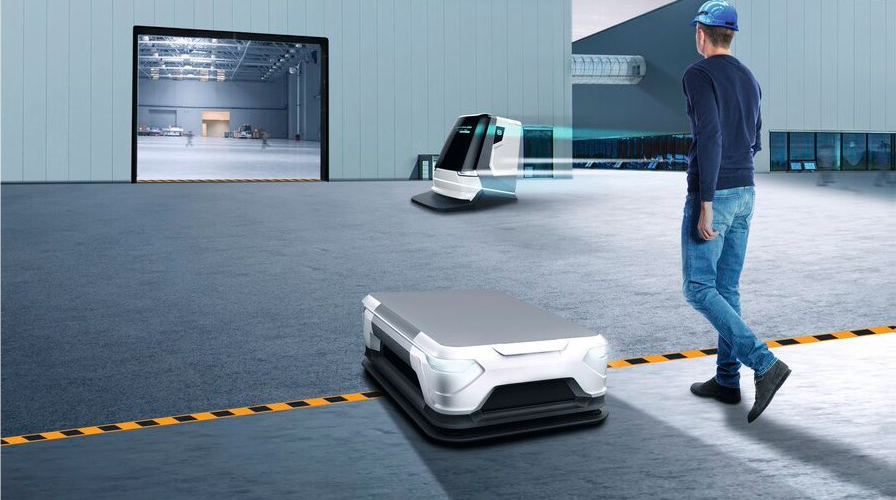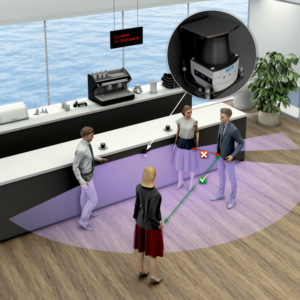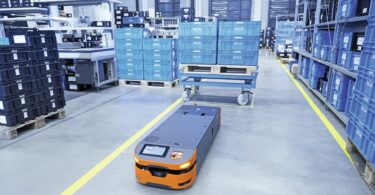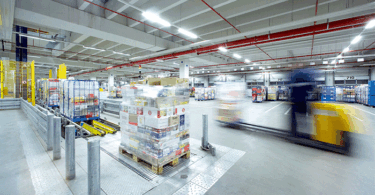Equipping autonomous and semi-autonomous vehicles with intelligent sensor technology, to develop safe, efficient distribution (DC) and fulfillment center (FC) operations
With automation making a big mark on the modern warehouse or DC, automatic guided vehicles (AGVs) and mobile collaborative robots continue to make their way into the fulfillment environment, where 34% and 20% (respectively) of companies are already using automated equipment to run their logistics operations.
A movement that was building significant momentum pre-COVID, the push to automate has been largely driven by labor shortages, space constraints, and the need to grow throughput in the safest, most economical way possible.
Over the next two years, 58% of companies will invest in shuttle systems and/or mobile robotic storage and retrieval systems (up from 47% that said they were in 2019), while 54% plan to implement palletizing robots (up from 47%). In addition, 51% of firms plan to implement goods-to-person picking solutions (up from 37%).
Supporting the modern warehouse
Mobile platforms also support social distancing in the workplace, where they help maintain a safe distance between and lessen close interaction among employees.
For this and other reasons, companies continue to implement more mobile platforms (e.g., AGVs, autonomous mobile robots [AMRs], and automated guided carts [AGCs]).
In some cases, simply choosing among AGVs, AMRs, and AGCs is a process that requires time, thought, and effort.
“In most cases, it comes down to the size and scale of the machine,” said Aaron Rothmeyer, market product manager for distance & ranging products at SICK, Inc.
For example, AGVs are larger mobile platforms that can handle heavy loads. Like AMRs, they help maximize space utilization and ease the burden on human workers. They also help maximize the number of picks per hour that a warehouse can complete, effectively increasing the amount of throughput for that facility. This, in turn, helps companies meet the ever-changing needs of their e-commerce and other sales channels.
By adding intelligent sensors to any or all of these mobile platforms, SICK helps create safer and more productive fulfillment environments that support all modern protocol while also enhancing companies’ profitability. Whether they’re buying the platforms outright or leasing them via the robotics-as-a-service (RaaS) model, companies can choose the option that best suits their budget and needs.
Key technology components
Using LiDAR and safety laser scanners, SICK provides enabling technologies that make mobile platforms safe, efficient, and productive. A method for measuring distances by illuminating the target with laser light and measuring the reflection with a sensor, LiDAR is the most prominent technology used, although both vision and laser are also finding their way into more warehouse automation. A laser distance sensor that rotates, LiDAR constantly scans the area around it, while single-point laser distance sensors measure the distance between the machine and a specific point. For example, to measure how high the forks are in the air on a semi-autonomous lift truck, a laser pointer can feed the operator an accurate measure by looking down (from the top) in a touch-free way.
“What you get from LiDAR and safety laser scanners is essentially a matrix, an occupancy grid that tells you where there are obstacles in the space. Once you let the AMR loose in your facility, it can discover all areas of the space—the walls, the racks, and so on,” Fetch Robotics’ Stefan Nusser pointed out. “And then it creates a map and compares the space it is driving around in to the map. That is how you keep the AMR localized. The laser scanner is one of the key sensor technologies that is enabling the market of AMRs.”
Along with improving safety in the warehouse or DC, intelligent sensors are flexible solutions that also help enhance overall operational performance.
“Just by adding intelligent sensors to mobile platforms,” Rothmeyer said, “we can make them work faster and more efficiently.”
Sensors that can detect whether a load is centered correctly, for example, help reduce throughput issues by alerting the operator well in advance (versus after the vehicle starts moving) of the problem.
Where SICK’s sensors are different is in their level of intelligence. For instance, the company’s distance sensors don’t just report the distance to a specific target; they also track ambient sensor temperature for the mobile platform itself. This helps operators spot equipment trends early and triggers the need for maintenance before a breakdown occurs.
Big advantages
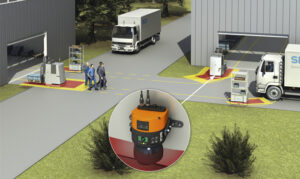
Safe interaction between humans and machines: This is what an outdoor non-contact sensor solution (outdoorScan3) might look like.
As warehouses and DCs seek out solutions that provide higher levels of autonomy, they’ll need intelligent sensors to serve as the “eyes and ears” for these equipment investments. By embedding those sensors into a range of different mobile platforms, SICK makes the modern fulfillment center more flexible, agile, and future-proof.
These sensors also make the workplace safer, both by reducing accidents involving humans and by eliminating contact between the mobile platforms and their surroundings (and, other vehicles). “Where a traditional AGV or AGC would stop and wait for the obstacle to be cleared, the one equipped with intelligent sensors will drive around it,” said Tom Bonucchi, sales manager, transport logistics, at SICK, Inc.
By offering a dynamic suite of intelligent sensors, SICK also allows companies to leverage multiple different products that come together to work as one complete system. And that system—which also integrates with a company’s enterprise resource planning (ERP) and other cloud-based business platforms—is perfectly suited for the job that is expected of it.
“Based on the job that the vehicle is performing, the sensor will go into a field that fits that environment as perfectly as possible,” said Bonucchi. “Our safety system takes input from the vehicle (i.e., steering angle, velocity, and load weight) and tailors the safety solution to the vehicle’s current task. That gives companies major safety and efficiency advantages over traditional sensors and autonomous systems.”
Want to learn more about this technology? Contact a SICK representative today!


